Bosch GOP55-36B, GOP40-30B Owner’s Manual
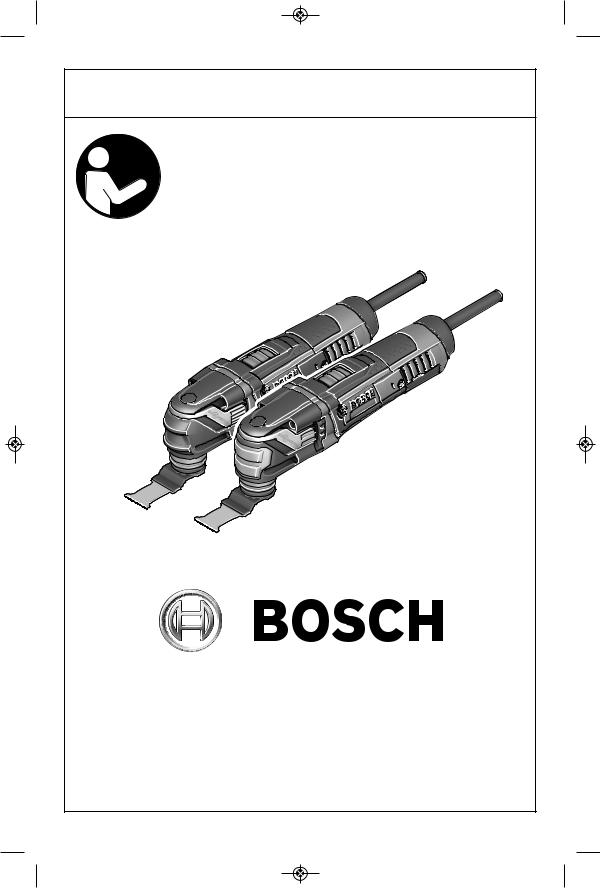
IMPORTANT: |
IMPORTANT : |
IMPORTANTE: |
Read Before Using |
Lire avant usage |
Leer antes de usar |
|
|
|
Operating/Safety Instructions 
 Consignes de fonctionnement/sécurité
Consignes de fonctionnement/sécurité
Instrucciones de funcionamiento y seguridad
GOP40-30
GOP55-36
|
|
|
|
|
|
|
|
|
|
|
|
|
|
|
|
|
|
|
|
|
|
|
|
|
|
|
|
Call Toll Free for |
Pour obtenir des informations |
Llame gratis para |
|
||||
Consumer Information |
et les adresses de nos centres |
obtener información |
|
|||||
|
& Service Locations |
|
de service après-vente, |
para el consumidor y |
|
|||
|
|
|
|
|
appelez ce numéro gratuit |
ubicaciones de servicio |
|
|
|
|
|
|
|
|
|
||
|
1-877-BOSCH99 (1-877-267-2499) www.boschtools.com |
|
|
|||||
|
|
|
|
|
|
|
|
|
For English Version |
|
Version française |
Versión en español |
|
||||
|
See page 2 |
|
Voir page 20 |
Ver la página 38 |
|
|||
|
|
|
|
|
|
|
|
|
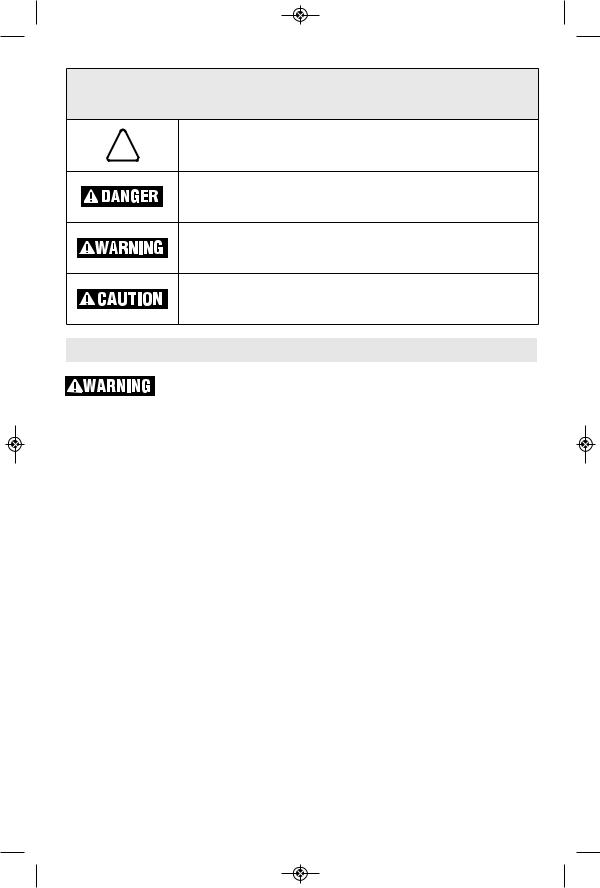
Safety Symbols
The definitions below describe the level of severity for each signal word. Please read the manual and pay attention to these symbols.
This is the safety alert symbol. It is used to alert you to potential
! personal injury hazards. Obey all safety messages that follow this symbol to avoid possible injury or death.
DANGER indicates a hazardous situation which, if not avoided, will result in death or serious injury.
or

Use personal protective equipment. Always wear eye protection. Protective equipment such as dust mask, non-skid safety shoes, hard hat, or hearing protection used for appropriate conditions will reduce personal injuries.
Prevent unintentional starting. Ensure the switch is in the off-position before connecting to power source and / or battery pack, picking up or carrying the tool.
Carrying power tools with your finger on the switch or energizing power tools that have the switch on invites accidents.
Remove any adjusting key or wrench before turning the power tool on. A wrench or a key left attached to a rotating part of the power tool may result in personal injury.
Do not overreach. Keep proper footing and balance at all times. This enables better control of the power tool in unexpected situations.
Dress properly. Do not wear loose clothing or jewelry. Keep your hair, clothing and gloves away from moving parts. Loose clothes, jewelry or long hair can be caught in moving parts.
If devices are provided for the connection of dust extraction and collection facilities, ensure these are connected and properly used. Use of dust collection can reduce dustrelated hazards.
Power tool use and care
Do not force the power tool. Use the correct power tool for your application. The correct power tool will do the job better and safer at the rate for which it was designed.
Do not use the power tool if the switch does
not turn it on and off. Any power tool that cannot be controlled with the switch is dangerous and must be repaired.
Disconnect the plug from the power source and/or the battery pack from the power tool before making any adjustments, changing accessories, or storing power tools. Such preventive safety measures reduce the risk of starting the power tool accidentally.
Store idle power tools out of the reach of children and do not allow persons unfamiliar with the power tool or these instructions to operate the power tool. Power tools are dangerous in the hands of untrained users.
Maintain power tools. Check for misalignment or binding of moving parts, breakage of parts and any other condition that may affect the power tool’s operation. If damaged, have the power tool repaired before use.
Many accidents are caused by poorly maintained power tools.
Keep cutting tools sharp and clean. Properly maintained cutting tools with sharp cutting edges are less likely to bind and are easier to control.
Use the power tool, accessories and tool bits etc. in accordance with these instructions, taking into account the working conditions and the work to be performed. Use of the power tool for operations different from those intended could result in a hazardous situation.
Service
Have your power tool serviced by a qualified repair person using only identical replacement parts. This will ensure that the safety of the power tool is maintained.
Safety Rules for Oscillating Tools
Hold power tool by insulated gripping surfaces, when performing an operation where the cutting accessory may contact hidden wiring or its own cord. Cutting accessory contacting a "live" wire may make exposed metal parts of the power tool "live" and could give the operator an electric shock.
Use clamps or another practical way to secure and support the workpiece to a stable platform. Holding the work by hand or against your body leaves it unstable and may lead to loss of control.
Do not drill, fasten or break into existing
walls or other blind areas where electrical wiring may exist. If this situation is unavoidable, disconnect all fuses or circuit breakers feeding this worksite.
Use a metal detector to determine if there are gas or water pipes hidden in the work area or call the local utility company for assistance before beginning the operation.
Striking or cutting into a gas line will result in explosion. Water entering an electrical device may cause electrocution.
Always hold the tool firmly with both hands for maximum control. Keep proper footing and balance at all times. This enables better
-3-

liquid, such as a solvent or water, or dampened such as newly applied wallpaper. There is an electrical shock hazard when working in such conditions with a power tool and heating of the liquid caused by scraping action may cause harmful vapors to be emitted from workpiece.
Always wear eye protection and a dust mask for dusty applications and when sanding overhead. Sanding particles can be absorbed by your eyes and inhaled easily and may cause health complications.
Use special precautions when sanding chemically pressure treated lumber, paint that may be lead based, or any other materials that may contain carcinogens. A suitable breathing respirator and protective clothing must be worn by all persons entering the work area. Work area should be sealed by plastic sheeting and persons not protected should be kept out until work area is thoroughly cleaned.
Do not use sandpaper intended for larger sanding pads. Larger sandpaper will extend beyond the sanding pad causing snagging, tearing of the paper or kick-back. Extra paper extending beyond the sanding pad can also cause serious lacerations.
Additional Safety Warnings
Always inspect accessories for damage (breakage, cracks) before each use. Never use if damage is suspected.
GFCI and personal protection devices like electrician’s rubber gloves and footwear will further enhance your personal safety.
Do not use AC only rated tools with a DC power supply. While the tool may appear to work, the electrical components of the AC rated tool are likely to fail and create a hazard to the operator.
Keep handles dry, clean and free from oil and grease. Slippery hands cannot safely control the power tool.
Develop a periodic maintenance schedule for your tool. When cleaning a tool be careful not to disassemble any portion of the tool since internal wires may be misplaced or pinched or safety guard return springs may be improperly mounted.
Certain cleaning agents such as gasoline, carbon tetrachloride, ammonia, etc. may damage plastic parts.
Risk of injury to user. The power cord must only be serviced by a Bosch Factory Service Center or Autho rized Bosch Service Station.
Some dust created by power sanding, sawing, grinding, drilling, and other construction
activities contains chemicals known to cause cancer, birth defects or other reproductive harm. Some examples of these chemicals are:
• Lead from lead-based paints,
• Crystalline silica from bricks and cement and other masonry products, and
• Arsenic and chromium from chemicallytreated lumber.
Your risk from these exposures varies, depending on how often you do this type of work. To reduce your exposure to these chemicals: work in a well ventilated area, and work with approved safety equipment, such as those dust masks that are specially designed to filter out microscopic particles.
-4-

Symbols
IMPORTANT: Some of the following symbols may be used on your tool. Please study them and learn their meaning. Proper interpretation of these symbols will allow you to operate the tool better and safer.
Symbol |
Designation / Explanation |
V |
Volts (voltage) |
A |
Amperes (current) |
Hz |
Hertz (frequency, cycles per second) |
W |
Watt (power) |
kg |
Kilograms (weight) |
min |
Minutes (time) |
s |
Seconds (time) |
Diameter (size of drill bits, grinding wheels, etc.)
|
|
|
|||||
|
n0 |
No load speed (rotational speed at no load) |
|||||
|
|
|
|
||||
|
|
n |
Rated speed (maximum attainable speed) |
||||
|
|
|
|
|
|
|
|
.../min |
Revolutions or reciprocation per minute (revolutions, strokes, surface speed, |
||||||
orbits etc. per minute) |
|||||||
|
|
|
|
|
|
||
|
|
|
|
||||
0 |
|
|
Off position (zero speed, zero torque...) |
||||
|
|
||||||
1, 2, 3, ... |
Selector settings (speed, torque or position settings. Higher number means |
||||||
I, II, III, |
greater speed) |
||||||
|
|
|
|
|
|
||
0 |
|
|
|
|
Infinitely variable selector with off (speed is increasing from 0 setting) |
||
|
|
|
|
|
|
|
|
|
|
|
|
|
|
Arrow (action in the direction of arrow) |
|
|
|
|
|
|
|
||
|
|
|
|
|
|
|
|
|
|
|
|
|
|
Alternating current (type or a characteristic of current) |
|
|
|
|
|
|
|
|
|
|
|
|
|
|
|
Direct current (type or a characteristic of current) |
|
|
|
|
|
|
|
||
|
|
|
|
|
|
|
|
|
|
|
|
|
|
Alternating or direct current (type or a characteristic of current) |
|
|
|
|
|
|
|
||
|
|
|
|
|
|
|
|
|
|
|
|
|
|
Class II construction (designates double insulated construction tools) |
|
|
|
|
|
|
|
|
|
|
|
|
|
|
|
Earthing terminal (grounding terminal) |
|
|
|
|
|
|
|
||
-5-
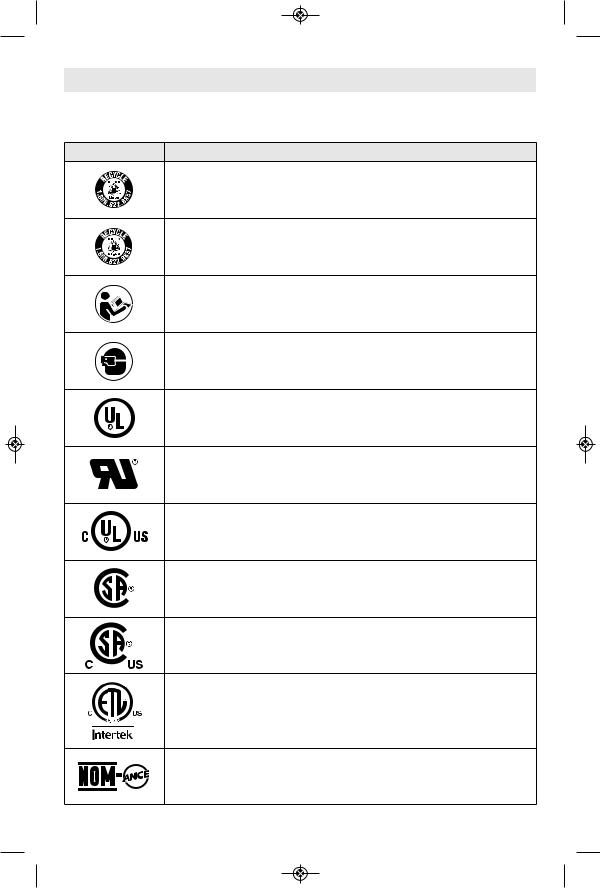
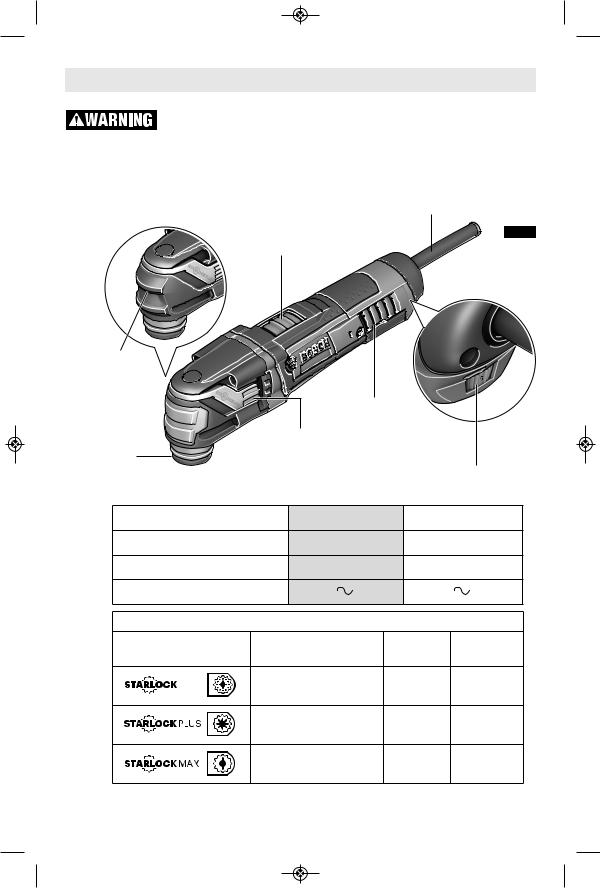
Functional Description and Specifications
Disconnect the plug from the power source before making any assembly, adjustments or changing accessories. Such preventive
safety measures reduce the risk of starting the tool accidentally.
Oscillating Power Tool
|
POWER |
|
|
CORD |
|
SLIDE |
FIG. 1 |
|
"ON/OFF" |
||
|
||
SWITCH |
|
LED WORK LIGHT |
|
|
|
|
|
|
(GOP40-30 ONLY) |
|
|
|
|
|
|
|
|
VENTILATION |
|
|
||
|
|
OPENINGS |
|
|
||
|
ACCESSORY |
|
|
|
|
|
ACCESSORY |
RELEASE |
|
|
|
|
|
LEVER |
|
|
|
|
||
HOLDER* |
|
|
|
|
||
|
|
|
VARIABLE SPEED |
|||
|
|
|
|
|||
|
|
|
|
CONTROL DIAL |
||
Model number |
GOP40-30 |
|
GOP55-36 |
|||
No load speed (n0) |
8,000-20,000/min |
|
8,000-20,000/min |
|||
Oscillating arc |
|
3.0° |
|
|
3.6° |
|
Voltage rating |
120 V |
60 Hz |
120 V |
60 Hz |
||
*Compatible accessory interface |
|
|
||||
Accessory |
Accessory |
GOP40-30 |
GOP55-36 |
|||
Model Number Range |
||||||
|
|
|
|
|||
|
OSL |
|
|
yes |
yes |
|
|
OSP |
|
|
yes |
yes |
|
|
OSM |
|
|
no |
yes |
|
NOTE: For tool specifications refer to the nameplate on your tool.
-7-
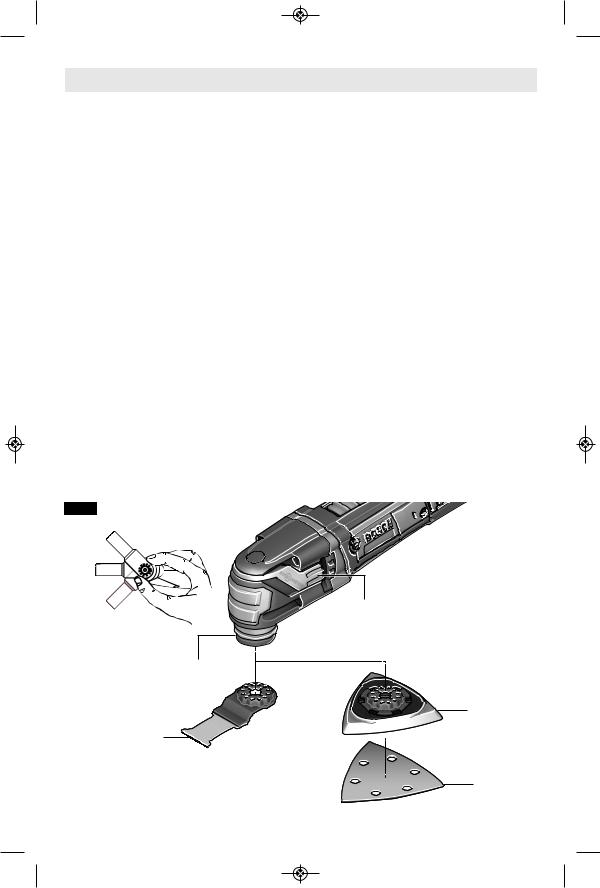
Assembly
|
|
|
Disconnect the plug from |
or angled to the left or right to enhance |
|||
|
|
|
|||||
|
|
|
the power source before |
usability. (Fig. 2) |
|||
|
|
|
|||||
making any assembly, adjustments or |
3. Press the oscillating tool into the accessory |
||||||
changing accessories. |
Such preventive |
holder until the holder’s clamping jaws |
|||||
safety measures reduce the risk of starting the |
“snaps” into the accessory. It is not |
||||||
tool accidentally. |
Only |
use |
Bosch |
necessary to open the accessory release |
|||
|
|
|
lever to install an accessory. |
||||
|
|
|
|||||
|
|
|
accessories rated 21000 |
REMOVING ACCESSORIES |
|||
|
|
|
|||||
OPM or greater. Using accessories not |
To remove accessory, open accessory release |
||||||
designed for this power tool may result in |
lever, and the accessory off will be released and |
||||||
serious personal injury and property damage. |
ejected off of the tool. |
||||||
|
|
|
For all work or when |
In order to help ensure that the tool has a solid |
|||
|
|
|
changing accessories |
grip of the accessory, clean the accessory |
|||
|
|
|
|||||
always wear protective gloves. |
Such |
holder and accessories as necessary with a |
|||||
preventive safety measures reduce the risk of |
clean cloth. |
||||||
injury from sharp edges of the accessories. |
INSTALLING AND REMOVING |
||||||
Accessories can become very hot while |
|||||||
working. Danger of burns! |
|
|
SANDING SHEETS |
||||
INSTALLING ACCESSORIES |
|
Your backing pad uses hook-and-loop backed |
|||||
|
accessories, which firmly grip the backing pad |
||||||
If necessary, remove an already-mounted |
|||||||
when applied with moderate pressure. |
|||||||
accessory. (See REMOVING ACCESSORIES |
1. Align the sanding sheet and press it onto the |
||||||
below) |
|
|
|
||||
|
|
|
sanding backing pad by hand. |
||||
1. Position the accessory such that its model |
|||||||
2. Firmly press the power tool with the sanding |
|||||||
number will face the oscillating tool’s |
|||||||
sheet against a flat surface and briefly |
|||||||
accessory holder (Fig. 2). |
|
|
|||||
|
|
switch the power tool on. This will promote |
|||||
2. Determine the desired angle of the |
|||||||
good adhesion and helps to prevent |
|||||||
accessory to the tool. Accessories can be |
premature wear. |
||||||
mounted such that they are oriented with |
3. To change, merely peel off the old sanding |
||||||
their working edge straight ahead of the tool, |
sheet, remove dust from the backing pad if |
|
|
FIG. 2 |
|
ACCESSORY
RELEASE
LEVER
ACCESSORY
HOLDER*
SANDING
BACKING PAD
PLUNGE CUT
BLADE
* See pages 10 - 14 for compatible accessory types. |
SHEET |
|
SANDING |
-8-

necessary, and press the new sanding sheet in place.
After considerable service the backing pad surface will become worn, and the backing pad must be replaced when it no longer offers a firm grip. If you are experiencing premature wear
out of the backing pad facing, decrease the amount of pressure you are applying during operation of the tool.
For maximum use of abrasive, rotate pad 120 degrees when tip of abrasive becomes worn.
Introduction |
|
INTENDED USE |
plastic components, and for grout removal |
This Bosch Oscillating Tool is intended for |
using the applicable tools and accessories |
dry sanding of surfaces, corners, edges, for |
recommended by Bosch. |
scraping, for sawing soft metals, wood and |
|
Operating Instructions |
|
LEARNING TO USE THE TOOL |
to the work surface and allow it to touch the |
Getting the most out of your oscillating tool is a |
point at which you want to begin. Concentrate |
matter of learning how to let the speed and the |
on guiding the tool over the work using very |
feel of the tool in your hands work for you. |
little pressure from your hand. Allow the |
The first step in learning to use the tool is to |
accessory to do the work. |
get the “feel” of it. Hold it in your hand and feel |
Usually it is better to make a series of passes |
its weight and balance (Fig. 4). Depending on |
with the tool rather than to do the entire job |
the application, you will need to adjust your |
with one pass. To make a cut, for example, |
hand position to achieve optimum comfort and |
pass the tool back and forth over the work. Cut |
control. The unique comfort grip on the body of |
a little material on each pass until you reach |
the tool allows for added comfort and control |
the desired depth. |
during use. |
SLIDE "ON/OFF" SWITCH |
FIG. 4 |
The tool is switched "ON" by the slide switch |
|
located on the topside of the motor housing |
|
(Fig. 1). |
|
TO TURN THE TOOL "ON" slide the switch |
|
button forward to the “I” . |
|
TO TURN THE TOOL "OFF" slide the switch |
|
button backward the “0” . |
|
ELECTRONIC FEEDBACK |
|
Your tool is equipped with an internal |
|
electronic feedback system that provides a |
|
“soft start”, which will reduce the stresses that |
|
occur from a high torque start. The system |
|
also helps to keep the preselected speed |
|
virtually constant between no-load and load |
When holding tool, do not cover the air vents |
conditions.BUILT IN WORK LIGHT |
with your hand. Blocking the air vents could |
(Model GOP40-30 Only) |
cause the motor to overheat. |
Model GOP40-30 is equipped with an LED |
IMPORTANT! Practice on scrap material first |
work light that turns on automatically when |
to see how the tool’s high-speed action |
the switch is activated (Fig. 1). |
performs. Keep in mind that your tool will |
|
perform best by allowing the speed, along with |
|
the correct accessory, do the work for you. Be |
|
careful not to apply too much pressure. |
|
Instead, lower the oscillating accessory lightly |
|
-9-

VARIABLE SPEED DIAL
This tool is equipped with a variable speed dial. The speed may be controlled during operation by presetting the dial in any one of six positions (Fig. 1).
OPERATING SPEEDS
The Bosch oscillating tools have a high oscillating motion of 8,000 - 20,000 /min (OPM). The high speed motion allows the Bosch tools to achieve with excellent results. The oscillating motion allows the dust to fall to the surface rather than slinging particles into the air.
To achieve the best results when working with different materials, set the variable speed control to suit the job (see Speed Range chart at right for guidance). To select the right speed for the accessory in use, practice with scrap material first.
NOTE: Speed is affected by voltages changes. A reduced incoming voltage will slow the OPM of the tool, especially at the
lowest setting. If your tool appears to be |
|
running slowly, increase the speed setting |
|
accordingly. The tool may not start at the |
|
lowest switch setting in areas where outlet |
|
voltage is less than 120 volts. Simply move |
|
the speed setting to a higher position to |
|
begin operation. |
|
The variable speed control settings are |
|
marked on the speed control dial. The |
|
settings for approximate /min (OPM) are: |
|
Speed Dial |
Speed Range |
Setting |
/min (OPM) |
1 |
8,000 |
2 |
10,400 |
3 |
12,800 |
4 |
15,200 |
5 |
17,600 |
6 |
20,000 |
Accessories
The GOP40-30 and GOP55-36 are compatible with StarLock family of accessories as indicated in the following chart
|
|
|
|
|
Accessory |
Accessory |
GOP40-30 |
GOP55-36 |
|
Model Number Range |
||||
|
|
|
||
|
OSL |
YES |
YES |
|
|
|
|
|
|
|
OSP |
YES |
YES |
|
|
|
|
|
|
|
OSM |
NO |
YES |
|
|
|
|
|
Only use Bosch accessories rated 21000 OPM or greater.
Using accessories not designed for this power tool may result in serious personal injury and property damage.
-10-
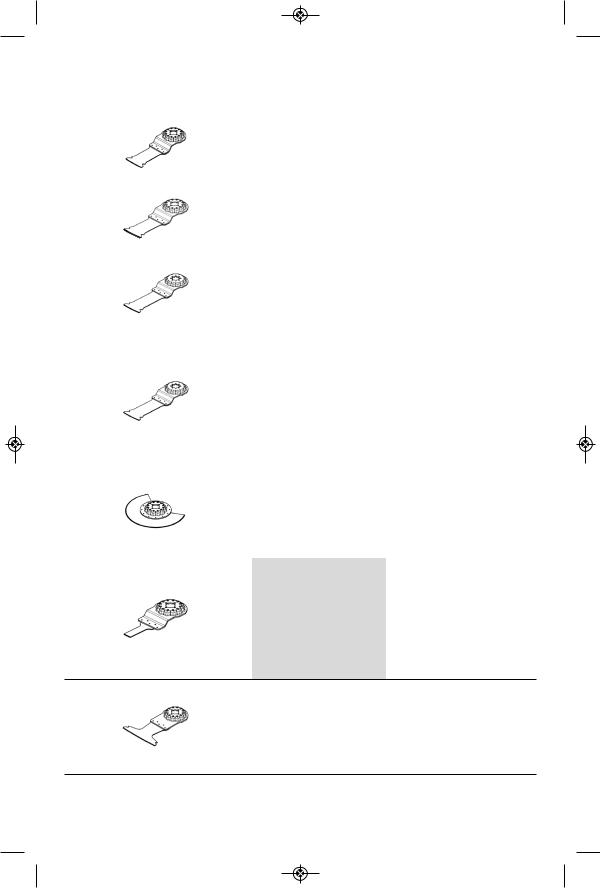
|
Accessory |
Material |
Application |
|
|
|
S A W I N G |
|
|
|
|
|
|
|
|
HCS plunge |
|
Separating and deep plunge cuts; |
|
|
|
also for sawing close to edges, in |
||
OSL114 |
cut saw |
- Wooden materials |
corners and hard to reach areas; |
|
OSP114 |
blade for |
- Soft plastics |
example: narrow plunge cut in |
|
|
wood |
|
solid wood for installing a |
|
|
|
|
ventilation grid. |
|
|
BIM plunge |
|
Plunge cuts in laminated panels |
|
OSL114JF |
cut saw |
- Hardwood |
||
or hardwood; example: installing |
||||
OSL212JF |
blade for |
- Laminated panels |
||
skylights. |
||||
|
hardwood |
|
||
|
|
|
||
|
|
|
|
|
|
|
|
Fast, deep separating and |
|
|
HCS plunge |
- Softwood |
plunge cuts; also for sawing |
|
OSM114 |
cut saw |
- Dowels |
close to edges in corners and |
|
blade for |
- Tenons |
hard to reach areas; example: |
||
|
||||
|
wood |
- Furniture components |
deep plunge cut in softwood for |
|
|
|
|
installing a ventilation grid. |
|
|
|
|
Fast, deep plunge cuts in wood, |
|
|
BIM plunge |
- Wood |
abrasive wooden materials and |
|
OSL114F |
plastics; example: fast cutting of |
|||
cut saw |
- Abrasive wooden materials |
non-ferrous metal pipes and |
||
OSM114F |
||||
blade for |
- Plastics |
profiles with smaller |
||
OSP114F |
||||
wood and |
- Hardened nails and screws |
dimensions, easy cutting of |
||
|
||||
|
metal |
- Non-ferrous metal pipes |
non-hardened nails, screws and |
|
|
|
|
steel profiles with smaller |
|
|
|
|
dimensions. |
|
|
BIM |
|
Separating and plunge cuts; also |
|
|
|
for sawing close to edges, in |
||
OSL312F |
segment |
- Wooden materials |
corners and hard to reach areas; |
|
saw blade |
- Plastic |
example: shortening already |
||
OSL400F |
||||
for wood |
- Non-ferrous metals |
installed bottom rails or door |
||
|
||||
|
and metal |
|
hinges, plunge cuts for adjusting |
|
|
|
|
floor panels. |
|
|
|
- Softwood |
|
OSL034F
OSL038F
- Soft plastics BIM plunge - Drywall
cut saw
blade for
- Thin-walled aluminum and
wood and
non-ferrous metal profiles
metal
- Thin sheet metals
- Non-hardened nails and screws
Smaller separating and plunge cuts; example: cutting an opening for sockets, flush cutting a copper pipe, plunge cuts in drywall. Filigree adjustment work in wood; example: sawing openings for locks and fittings.
|
BIM plunge |
- Softwood |
|
|
- Hardwood |
||
OSP212F |
cut saw |
- Veneered panels |
|
blade for |
|||
- Plastic-laminated panels |
|||
|
wood and |
||
|
- Non-hardened nails and |
||
|
metal |
||
|
screws |
||
|
|
||
|
|
|
Plunge cuts in laminated panels or hardwood; example: shortening door frames, cutting openings for a shelf.
HCS - High Carbon Steel; BIM - Bi-Metal; CG - Carbide Grit.
-11-

|
Accessory |
Material |
Application |
||
|
|
|
|
||
|
|
- Softwood, |
|
||
|
BIM |
Hardwood |
Fast, deep plunge cuts in wood and |
||
OSL212F |
plunge cut |
- Veneered panels |
metal; example: quick cutting of wood |
||
saw blade |
- Plastic-laminated |
containing nails, deep plunge cuts in |
|||
OSM200F |
|||||
for wood |
panels |
|
laminated panels and precise |
||
|
|
||||
|
and metal |
- Non-hardened nails |
shortening of door frames. |
||
|
|
and screws |
|
||
|
|
- Metal |
|
|
|
OSL034C |
Carbide |
- Extremely abrasive |
Plunge cuts in extremely abrasive |
||
materials |
|
materials or metal; example: cutting |
|||
plunge cut |
|
||||
OSL114C |
- Fiberglass |
|
kitchen front covers, easy cutting |
||
OSL134C |
saw blade |
- Drywall |
|
through hardened screws, nails and |
|
|
for metal |
- Cement-bonded fiber |
stainless steel. |
||
|
|
||||
|
|
boards |
|
|
|
|
|
- Stainless steel |
|
||
|
|
(Inox) |
|
Fast, deep plunge cuts in extremely |
|
|
Carbide |
- Screws and nails |
|||
OSM114C |
- Epoxy resin |
abrasive materials or metal; example: |
|||
plunge cut |
|||||
OSP114C |
saw blade |
- Glass fiber |
fast cutting of kitchen front covers, |
||
OSP134C |
for metal |
reinforced plastics |
easy cutting through hardened screws, |
||
|
- Fiberglass |
nails and stainless steel. |
|||
|
|
||||
|
|
- Drywall |
|
|
|
|
|
- Porous concrete |
|
||
|
O T H E R |
C U T T I N G |
|||
- Roofing felt
 HCS multi - Carpets OSL138K - Artificial turf
HCS multi - Carpets OSL138K - Artificial turf
blade
- Cardboard
- PVC flooring
Fast, precise cutting of soft material and flexible abrasive materials; example: cutting carpets, cardboard, PVC flooring, roofing felt, etc.
|
|
- Carpets |
|
OSL200RS |
Rigid |
- Mortar |
|
scraper |
- Concrete |
||
|
|||
|
|
- Tile adhesive |
|
|
|
|
Scraping on hard surfaces; example: removing mortar, tile adhesive, concrete and carpet adhesive residues.
|
Flexible |
- Carpet adhesive |
Flexible scraping on soft surfaces; |
|
|
- Paint residues |
|||
OSL200FS |
example: removing silicone joints, carpet |
|||
scraper |
||||
|
- Silicone |
adhesive and paint residues. |
||
|
|
|||
|
|
|
||
|
|
|
|
|
|
|
- Insulation material |
|
|
|
|
- Insulation panels |
|
|
|
BIM |
- Floor panels |
Precise cutting of soft materials; |
|
|
- Sound-dampening |
|||
OSL400K |
serrated |
example: cutting insulation panels to |
||
floor panels |
||||
OSM212K |
segment |
size, flush cutting protruding insulation |
||
- Cardboard |
||||
|
saw blade |
material to length. |
||
|
- Carpets |
|||
|
|
- Rubber
- Leather
HCS - High Carbon Steel; BIM - Bi-Metal; CG - Carbide Grit.
-12-
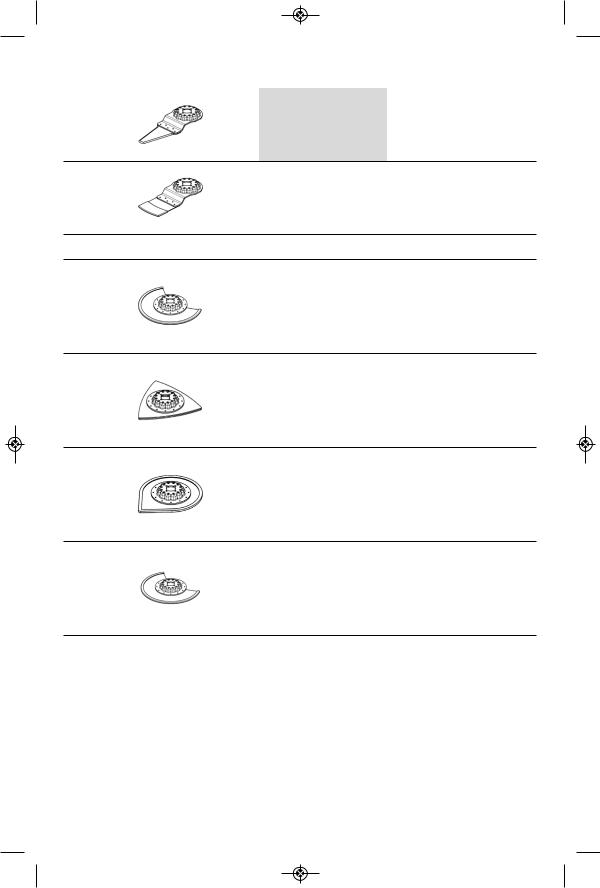
Accessory |
Material |
Application |
|
|
|
OSL214K
OSM114K
OSM314K
HCS
- Expansion joints
universal
- Putty
joint cutter - Insulation materials (rock wool)
Cutting and separating soft materials; example: cutting silicone expansion joints or putty.
|
CG plunge |
- Fiberglass |
OSL114CG |
cut saw |
- Mortar |
|
blade |
- Wood |
|
|
|
Plunge cuts in extremely abrasive materials; example: routing thin mosaic tiles.
G R I N D I N G
|
Diamond- |
- Cement joints |
|
OSL312DG |
- Soft wall tiles |
||
OSM212DG |
Grit |
- Epoxy resin |
|
segment |
|||
|
- Glass fiber reinforced |
||
|
saw blade |
||
|
|
plastics |
|
|
|
|
Precise routing and cutting of tile/joint material, epoxy resins and glass fiber reinforced plastics; example: making smaller cutouts in soft wall tiles and routing openings in glass fiber reinforced plastic.
|
|
- Mortar |
|
OSL300CR |
CG delta |
- Concrete residues |
|
plate |
- Wood |
||
|
|||
|
|
- Abrasive materials |
|
|
|
|
Rasping and sanding on hard surfaces; example: removing mortar or tile adhesive (e.g. when replacing damaged tiles), removing carpet adhesive residues.
|
|
- Mortar |
|
|
CG grout |
- Joints |
|
OSL234HG |
and |
- Epoxy resin |
|
mortar |
- Glass fiber reinforced |
||
|
|||
|
remover |
plastics |
|
|
|
- Abrasive materials |
|
|
|
|
Routing and cutting joint and tile material and rasping and sanding on hard surfaces; example: removing tile adhesive and grout.
OSL212CG |
CG |
- Cement joints |
|
- Soft wall tiles |
|||
OSL312LG |
|||
segment |
- Glass fiber reinforced |
||
OSM212CG |
|||
saw blade |
plastics |
||
OSM212LG |
|||
|
- Porous concrete |
||
|
|
||
|
|
|
Cutting and separating close to edges, in corners or hard to reach areas; example: removing grouting joints between wall tiles for repair work, cutting openings in tiles, drywall or plastic.
HCS - High Carbon Steel; BIM - Bi-Metal; CG - Carbide Grit.
-13-
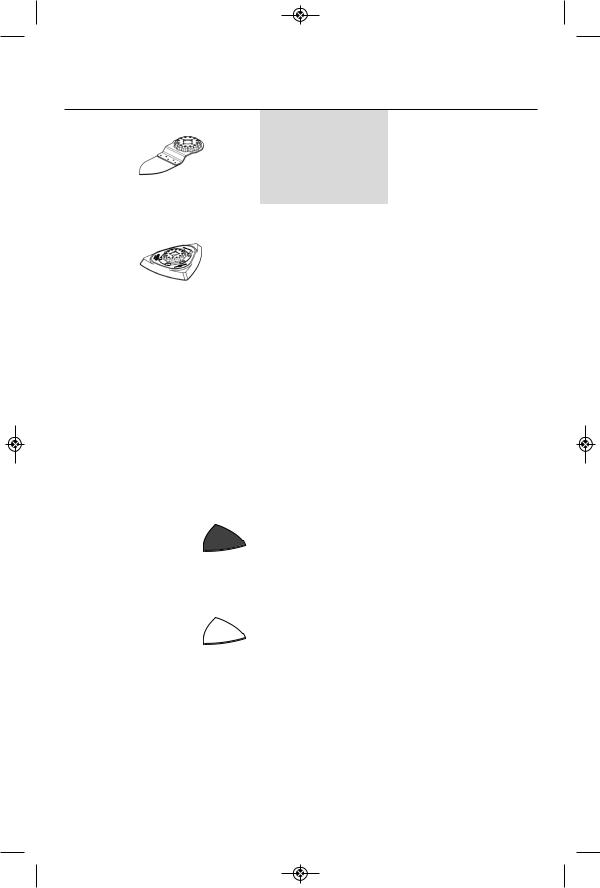
Accessory |
Material |
Application |
|
|
|
S A N D I N G
CG OSL200CR sanding
- Wood
finger
- Paint
Sanding wood or paint in hard to reach areas without sanding paper; example: sanding off paint between shutter louvers, sanding wooden floors in corners.
|
|
|
Sanding surfaces close to edges, |
||||
|
Sanding |
|
in corners or hard to reach areas; |
||||
|
|
depending on the sanding sheet |
|||||
|
backing |
|
for, e.g., sanding wood, paint, |
||||
OSL350SD |
pad, |
- Depends on sanding sheet |
varnish, stone. Fleeces for |
||||
|
series |
|
cleaning and for texturing wood, |
||||
|
Delta 3.5” |
|
removing rust from metal and for |
||||
|
|
|
keying varnishes, polishing felt |
||||
|
|
|
for prepolishing. |
|
|
||
|
|
|
|
|
|
|
|
|
HCS - High Carbon Steel; BIM - Bi-Metal; CG - Carbide Grit. |
|
|
|
|||
|
|
|
|
|
|
|
|
|
Selecting Sanding/Grinding Sheets |
|
|
|
|||
|
|
|
|
|
|
|
|
Material |
|
Application |
|
Grit Size |
|
||
All wooden materials (e.g., |
For coarse-sanding, e.g. of |
|
Coarse |
40/60 |
|
||
hardwood, softwood, chipboard, |
rough, unplanned beams and |
|
|
|
|
||
building board) |
Metal materials– |
boards |
|
|
|
|
|
Metal materials, fiberglass |
For face sanding and planing |
|
Medium |
80/120 |
|
||
and plastics |
|
small irregularities |
|
|
|
|
|
|
Sand Paper (Red) |
For finish and fine sanding of |
|
Fine |
180/240 |
|
|
|
wood |
|
|
|
|
||
Paint, varnish, filling compound |
For sanding off paint |
|
Coarse |
40/60 |
|
||
and filler |
|
|
|
|
|
|
|
|
For sanding primer (e.g., for |
|
Medium |
80/120 |
|
||
|
|
|
|
||||
|
|
removing brush dashes, drops |
|
|
|
|
|
|
|
of paint and paint run) |
|
|
|
|
|
|
Sand Paper (White) |
|
|
|
|
|
|
|
For final sanding of primers |
|
Fine |
180/240 |
|
||
|
|
|
|
||||
|
|
before coating |
|
|
|
|
|
|
|
|
|
|
|
|
|
-14-
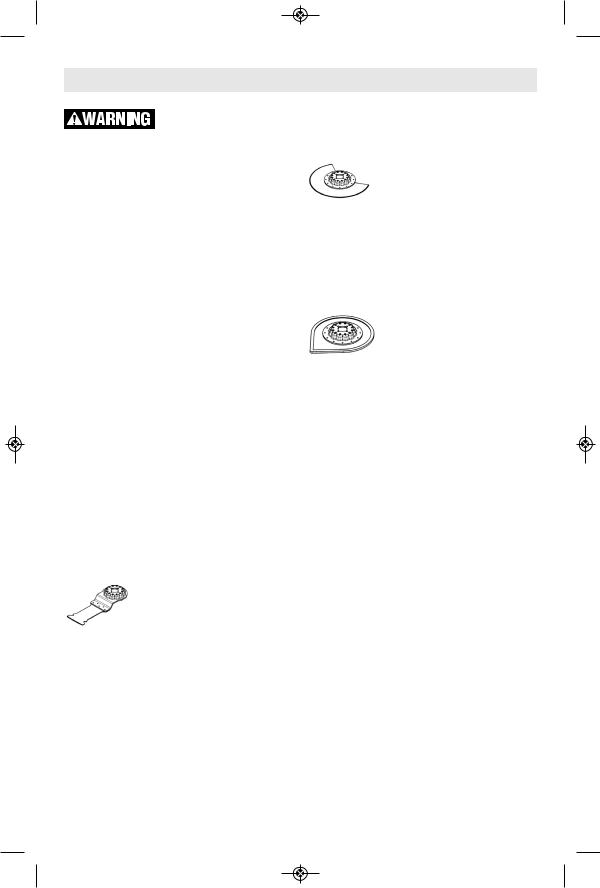
Common Applications
For all accessories, work from the body. with the accessory away
Never position hand near or directly in front of working area. Always hold the tool with both hands and wear protective gloves.
Below are some typical uses for your Bosch oscillating tool.
Flush Cutting
Remove excess wood from door jamb, window sill and/or toekick. Removing excess copper or PVC pipe.
Removal work
e.g. carpets & backing, old tile adhesives, caulking on masonry, wood and other surfaces.
Removal of excess materials
e.g. plaster, mortar splatters, concrete on tiles, sills.
Preparation of surfaces e.g. for new floors and tiles.
Detail sanding
e.g. for sanding in extremely tight areas otherwise difficult to reach and require hand sanding
CUTTING
Saw blades are ideal for making precise cuts in tight areas, close to edges or flush to a surface.
Select a medium to high speed for making initial plunge, start off at medium speed for increased control. After making your initial cut, you can increase speed for faster cutting ability. Flush cutting blades are
intended to make precise cuts to allow for installation of flooring or wall material. When flush cutting
it is important not to force the tool during the plunge cut. If you experience a strong vibration in your hand during the plunge cut, this indicates that you are applying too much pressure. Back the tool out and let the speed of the tool do the work. While keeping the teeth of the blade in the work surface, move the back of the tool in a slow sideways motion. This motion will help expedite the cut.
When making a flush cut it is always a good idea to have a piece of scrap material (tile or
wood) supporting the blade. If you need to rest the flush cutting blade on a delicate surface, you should protect the surface with cardboard or masking tape.
The segment saw blade is ideal for making precise cuts in wood, plaster, drywall material.
s include cutting openings in flooring for venting, repairing damaged flooring, cutting openings for electrical boxes. The blade works best on softer woods such as pine. For harder woods, the blade life will be limited.
Select a medium to high speed.
GROUT REMOVAL
Grout removal blades are ideal for removing damaged or cracked grout. Grout blades come in different widths (1/16"
and 1/8") to tackle different grout line widths. Before selecting a grout blade measure the grout line width to pick the appropriate blade.
Select a medium to high speed.
To remove the grout, use a back and forth motion, making several passes along the grout line. The hardness of the grout will dictate how many passes are needed. Try and keep the grout blade aligned with the grout line and be careful not to apply too much side pressure on the grout blade during the process. To control plunge depth use the carbide grit line on the blade as an indicator. Be careful not to plunge beyond the carbide grit line to avoid damage to the backer board material.
The grout blades can handle both sanded and unsanded grout. If you notice the blade clogging during the grout removal process, you can use a brass brush to clean the grit, thus exposing the grit again.
The grout blade geometry is designed so that the blade can remove all grout up to the surface of a wall or corner. This can be accomplished by ensuring that the segmented portion of the blade is facing the wall or corner.
SCRAPING
Scrapers are suitable for removing old coats of varnish or adhesives, removing bonded carpeting, e.g. on stairs/steps and other small/medium size surfaces.
Select low to medium speed.
-15-
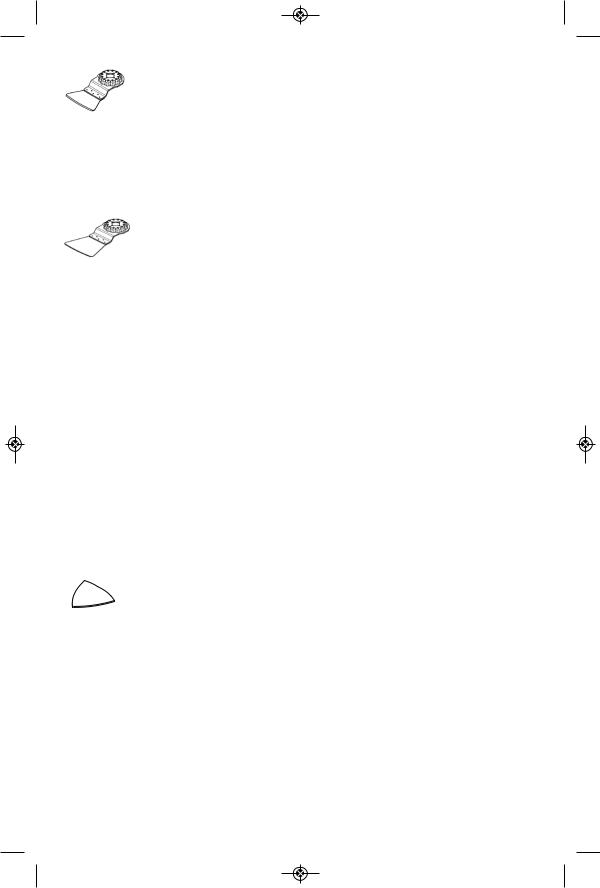
Rigid scrapers are for large area removal, and harder materials such as vinyl flooring, carpeting and tile adhesives. When
removing strong, tacky adhesives, grease the scraper blade surface with (petroleum jelly or silicone grease) to reduce gumming up.
The carpet/vinyl flooring removes easier if it is scored prior to removal so the scraper blade can move underneath the flooring material.
Flexible scrapers are used for hard to reach areas and softer material such as caulk.
craper blade with the logo side facing up. With the flexible scraper, make sure that the screw head does not make contact with surface during the scraping process (a 30 - 45 degree pitch is recommend). This can be accomplished by making sure that the tool is at an angle to the blade. You should be able to see the blade flex during the scraping process. If you are removing caulk from a delicate surface such as a bath tub or tile back splash, we recommend taping or protecting the surface that the blade will rest on. Use rubbing alcohol to clean the surface after the caulk and/or adhesive is removed.
Turn the tool on and place desired accessory on the area where material is to be removed. Begin with light pressure. The oscillating motion of accessory only occurs when pressure is applied to the material to be removed.
Excessive pressure can gouge or damage the background surfaces (e.g,. wood, plaster).
SANDING
Sanding accessories are suitable for dry sanding of wood, metal, surfaces, corners and edges and
hard to reach areas.
Work with the complete surface of the sanding pad, not only with the tip.
Corners may be finished using the tip or edge of the selected accessory, which should occasionally be rotated during use to distribute the wear on the accessory and backing pad surface.
Sand with a continuous motion and light |
|
pressure. DO NOT apply excessive pressure - |
|
let the tool do the work. Excessive pressure |
|
will result in poor handling, vibration, and |
|
unwanted sanding marks and premature wear |
|
on the sanding sheet. |
|
Always be certain that smaller workpieces are |
|
securely fastened to a bench or other support. |
|
Larger panels may be held in place by hand on |
|
a bench or sawhorses. |
|
Open-coat aluminum oxide sanding sheets are |
|
recommended for most wood or metal sanding |
|
applications, as this synthetic material cuts |
|
quickly and wears well. Some applications, |
|
such as metal finishing or cleaning, require |
|
special abrasive pads which are available from |
|
your dealer. For best results, use Bosch |
|
sanding accessories which are of superior |
|
quality and are carefully selected to produce |
|
professional quality results with your oscillating |
|
tool. |
|
The following suggestions may be used as a |
|
general guide for abrasive selection, but the |
|
best results will be obtained by sanding a test |
|
sample of the workpiece first. |
|
Grit |
Application |
Coarse |
For rough wood or metal |
|
sanding, and rust or old |
|
finish removal. |
Medium |
For general wood or metal |
|
sanding |
Fine |
For final finishing of wood, |
|
metal, plaster and other |
|
surfaces. |
With the workpiece firmly secured, turn tool on as described above. Contact the work with the tool after the tool has reached its full speed, and remove it from the work before switching the tool off. Operating your oscillating tool in this manner will prolong switch and motor life, and greatly increase the quality of your work.
Move the oscillating tool in long steady strokes parallel to the grain using some lateral motion to overlap the strokes by as much as 75%. DO NOT apply excessive pressure - let the tool do the work. Excessive pressure will result in poor handling, vibration, and unwanted sanding marks.
-16-

FIG. 5
SANDING TECHNIQUES
CORRECT: Sand with a smooth back and forth motion, allowing the weight of the tool to do the work.
INCORRECT: Avoid sanding with only the tip of the pad. Keep as much sand paper in touch with the work surface as possible.
CORRECT: Always sand with the pad and sandpaer flat against the work surface. Work smoothly in a back and forth motion.
INCORRECT: Avoid tipping the pad. Always sand flat.
CUTTING TECHNIQUES |
FIG. 6 |
|
CORRECT: Always cut with a smooth back and forth motion. Never force the blade. Apply light pressure to guide the tool.
INCORRECT: Do not twist the tool while cutting.This can cause the blade to bind.
SCRAPING TECHNIQUES
CORRECT: Make sure flexible scraper blade flexes enough
INCORRECT: Avoid screw head touching surface with flexible scraper blade.
-17-
